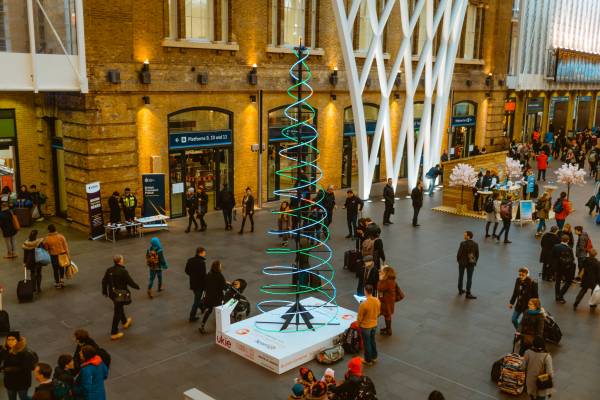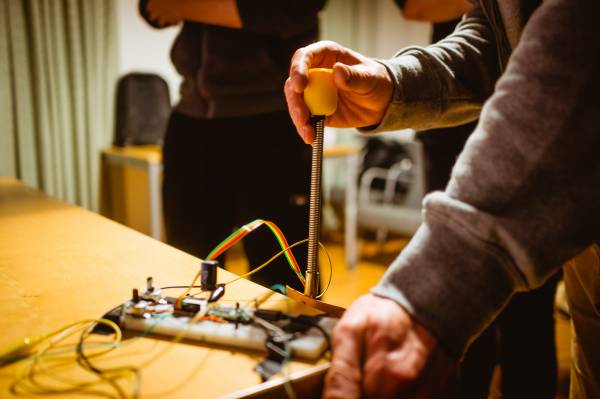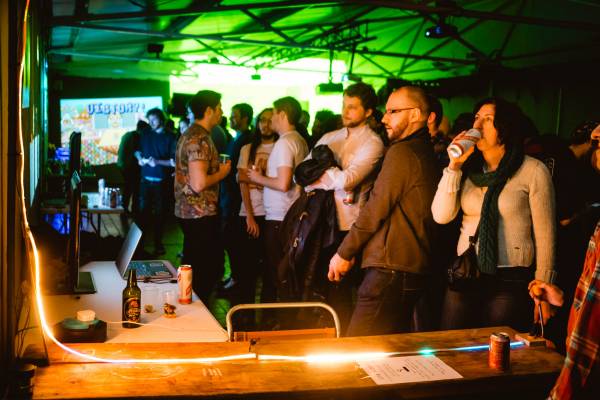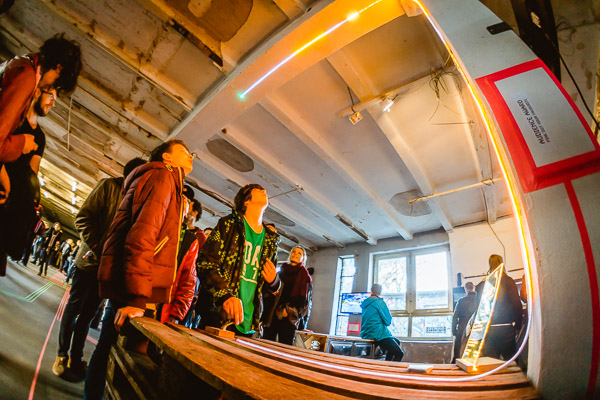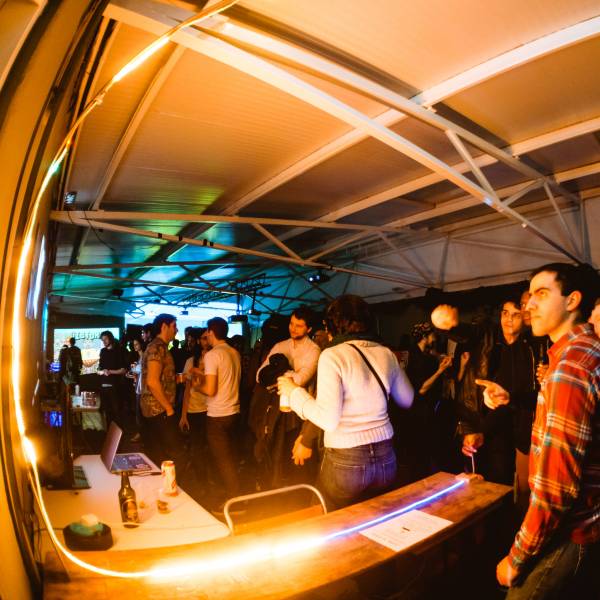Line Wobbler
Line Wobbler is a one-dimensional dungeon crawler game with a unique wobble controller made out of a door-stopper spring and a several meter long ultrabright LED strip display. The entire game runs on an arduino, including sound, particle effects and 60+fps.
It's been exhibited in quite a few places now (such as the Experimental Gameplay Workshop at GDC 2015, Burning Man 2015, London, Chicago and Oslo) and won two prizes at the AMAZE Awards 2015 in Berlin.
Line Wobbler has won the Game Design Award at IndieCade 2015 in Los Angeles, and the Best Game Design, Best Presentation, and the Audience Awards at Sense Of Wonder Night at the Tokyo Game Show 2016.
A special festive two player 25 meter Christmas tree version has been built for Kings Cross Station in December 2017, there's a dedicated page for it here .
Line Wobbler is part of the major V&A exhibition Videogames: Design/Play/Disrupt, running now until the 24th of February 2019 at the Victoria & Albert Museum in London!
Subscribe to my Line Wobbler & co Newsletter
The Controller
Using a spring, an accelerometer and a rigid surface, the Wobble controller is a tactile and surprisingly precise joystick with a unique 'wobble' action (pull it back and let go to make it oscillate back and forth rapidly). It is this wobble action that is core to the experience and the game we have created for it. Initially made out of a shoe-tree spring and door-stopper springs, I'm now using custom made springs that have been designed specifically for Line Wobbler. Fun fact: the original inspiration for the controller came from this cat video.
The Display
We use a long strip of densely packed LEDs, which are both super™ bright and physically flexible. Using selective brightness for specific particle effects, we evoke the retro-feeling of vector-displays (remember the bullets in asteroids? Very satisfying!).
The flexibility of the strip allows us to incorporate physical space into the game by bending and looping the display around objects and walls, and modifying in-game objects according to the strips' orientation, breaking out of the rigid linearity that a 1D display imposes.
Note: The display is actually so bright that it's quite hard to film and take photos of it, appearing a bit washed-out on the media below.
Line Wobbler Gameplay
The game is a one-dimensional dungeon-crawler where the player navigates obstacles and fights enemies to reach the exit. Movement is controlled by bending the Wobble controller left and right, while enemies are attacked by wobbling. Obstacles such as lava fields, conveyor belts and slopes (which can be modelled according to how the strip is placed in real life) challenge the navigation skills of the player.
The sound effects are basic modulations of sine-waves, whose frequency is directly controlled by the acceleration of the controller, enhancing the wobble effect.
Gameplay video from a Warehouse Gaming Party in London:
Here I introduce the game and Anton plays the first few levels:
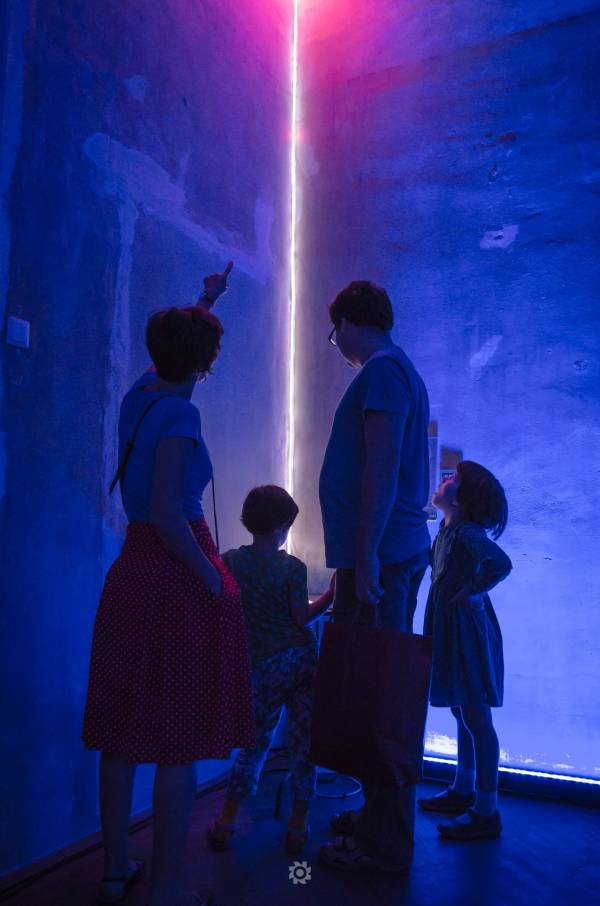 (Photo by Robert Puteanu)
(Photo by Robert Puteanu)
Multiplayer Games in Development
I've started making more wobble controllers, and I'm experimenting with multiplayer concepts, such as deadly tennis:
More Photos & Videos
(Test of a 20 meter version - a lot of wire!)
(Cats love the green light!)
FLickr Album of the Line Wobbler at various parties
Exhibitions
Current and Ongoing Exhibitions
- Game Science Center, Berlin, Germany
- Jepson Center, Telfair Museum, Savannah, GA, USA
- Orlando Science Center, Orlando, Florida, USA
- Videogames: Design/Disrupt/Play Exhibition at the Victoria & Albert Museum London, UK
- Wonderville NYC Bar, Brooklyn, USA
Exhibition History
- Created at and winner of 'Best Game' at the Exile.dk Game Jam, Valleskilde, DK, Oct 29 - Nov 2 2014
- Exhibited at Joypad Warehouse Gaming Party, London, UK, 15th Nov 2014 and 31st Jan 2015
2015
- Exhibited at Game Science Center Berlin special exhibition on Alternative Controllers, 8th Dec 2014 - 8th Jan 2015.
- Exhibited at ALT.CTRL.GDC at the Game Developer Conference in San Francisco, March 2015
- Exhibited at the Experimental Gameplay Workshop also at the Game Developer Conference in San Francisco, March 2015
- Exhibited at Rezzed in London, March 2015
- Exhibited at Loading Bar in North London, March 2015
- Exhibited at Norwich Gaming Festival in Norwich, UK, April 2015
- Exhibited at AMAZE Festival in Berlin, Germany, April 2015
- Exhibited at w00t Festival in Copenhagen, Denmark, May 2015
- Exhibited at Spillkonvent 2015 in Oslo, Norway, June 2015.
- Exhibited at Wellcome Collection: Friday Late Spectacular: Play in London, UK, July 2015
- Exhibited at Bit Bash Chicago, August 2015
- Exhibited at Victoria & Albert Museum presents Friday Late: Pushing Buttons, London, UK, August 2015
- Exhibited at Burning Man, Nevada, US, September 2015
- Exhibited at Now Play This, Somerset House, London, UK, September 2015
- Exhibited at A MAZE./Johannesburg, South Africa, September 2015
- Exhibited at PLAY15, Hamburg, Germany, September 2015
- Exhibited at P Storm Museet, Copenhagen, Denmark
- Exhibited at Clujotronic, Cluj, Romania, September 2015
- Exhibited at Pop Up Arcade, Brighton, UK, September 2015
- Exhibited at DR Games Week, Copenhagen, DK, September 2015
- Exhibited at Eurogamer Expo, Birmingham, UK, September 2015
- Exhibited at Maker Faire Rome, Italy, October 2015
- Exhibited at ExtraLife Exhibition, Nürnberg, Germany, Oct 2015
- Exhibited at IndieCade, Los Angeles, USA, Oct 2015 (Selected as Finalist!)
- Exhibited at Zoo Machines Festival, Lille, France, Nov 2015
- Exhibited at Day of the Devs, San Francisco, US, 7 Nov 2015
- Exhibited at 2015 UCLA Game Art Festvial Hammer Museum, LA, US, 18 Nov 2015
- Exhibited at VICE UK & Joypad Game Night, London, UK, 5 Dec 2015
- Exhibited at Slamdance Digital Interactive & Gaming 2015 Showcase, Los Angeles, USA, 5-13 Dec 2015
- Exhibited at Christmas Tree edition at Secret Weapon Bar, London, UK, Dec 2015
2016
- Exhibited at Zealous X Festival, London, UK, 7-17 Jan 2016
- Exhibited at Slamdance Film festival DIG Showcase, Park City, Utah, USA, 22-28 Jan 2016
- Exhibited at TIFF DigiPlaySpaces, Toronto, Canada, 5 Mar - 25 April 2016
- Exhibited at Day of the Devs @ GDC 2016, San Francisco, USA, 14 - 18 Mar 2016
- Exhibited at The Gadget Show Live, Birmingham, UK, 31 Mar - 3 April 2016
- Exhibited at Rocket Jump Event, UKIE London, UK, 6 April 2016
- Exhibited at The Brain 2: RoboLab Residency, Institut Francais Berlin, Germany, 10-18 April 2016
- Exhibited at AMAZE Super Open Sound System, AMAZE 2016, Berlin, 20-23 April 2016
- Exhibited at IndieCade East 2016 Strange Arcade, New York City, 29 Apr - 1 May 2016
- Exhibited at Babycastles IndieCade Afterparty, NYC, US, 1 May 2016
- Exhibited at GameCamp 8, London, UK, 21 May 2016
- Exhibited at Feral Vector 2016, Hebden Bridge, UK, 2-4 June 2016
- Exhibited at State Of Play 2016, Dublin, Ireland, 8th June 2016
- Exhibited at Destination Moon Music & Art Festival, Wurtsboro, NY, 17-19 June 2016
- Exhibited at Progress Bar June, Brighton, UK, 16-17 June 2016
- Exhibited at Fun and Games Exhibition, Perth Museum and Art Gallery, Perth, UK, 28 Jun - 21 Aug 2016
- Exhibited at The Children's Media Conference Playground, Sheffield, UK, 5-10 July 2016
- Exhibited at Out of Index festival, Seoul, South Korea, 23rd Jul 2016
- Exhibited at PlayParty, DiGRA and FDG First Joint International Conference, Dundee, UK, 2 Aug 2016
- Exhibited at Platine Festival, Cologne, Germany 15-18 Aug 2016
- Exhibited at Respawn Gathering, Cologne, Germany, 15-16 Aug 2016
- Exhibited at Gamescom Expo, Cologne, Germany, 17-21 Aug 2016
- Exhibited at LOW-LEVEL 2016 music festival, Brooklyn, NY, 19-20 Aug 2016
- Exhibited at AMAZE Pop-Up: The District, Abu Dhabi, UAE, 8-10 Sept 2016
- Exhibited at Tokyo Game Show, Tokyo, Japan, 15-18 Sept 2016
- Exhibited at Busan Indie Connect, Busan, South Korea, 10 Sept 2016
- Exhibited at Hand Eye Society Ball, Toronto, Canada, 12 Sept 2016
- Exhibited at SAE Alumni Convention, Cologne, 11-12 Oct 2016
- Exhibited at We Throw Switches, Edinburgh, UK, 20 Oct 2016
- Exhibited at Full Indie Summit, Vancouver, Canada, 22 Oct 2016
- Exhibited at GameZ Festival, Zürich, Switzerland, 4-6 Nov 2016 - Photo
- Exhibited at Deutscher Multimedia Preis 2016, Dresden, 12-13 Nov 2016
- Exhibited at IndieCade Europe, Paris, France, 18-19 Nov 2016
2017
- Exhibited at Pulse Festival, Savannah GA, USA, 11-15 Jan 2017
- Exhibited at GamerDisco + Lights of Soho Party, London, UK, 25 Jan 2017
- Exhibited at Explorers Fair, Nottingham, UK, 9-11 Feb 2017
- Exhibited at Tokyo Indie Fest, Tokyo, Japan, 13-14 May 2017
- Exhibited at Bitsummit 2017, Kyoto, Japan, 20-21 May 2017
- Exhibited at Medialab Shanghai, China, June - December 2017
- Exhibited at Eureka! The National Children's Museum, Halifax, UK, July 2017 - March 2018
- Exhibited at Edinburgh Fringe Festival - Futureplay, Edinburgh, UK, Aug 2017
- Exhibited at Discovery Place, Charlotte, NC, USA, Summer 2017 (ongoing)
- Exhibited at Arcadia Dundee, UK, 8 Sep 2017
- Exhibited at Be My Human Video Game Night, Barcelona, Spain, 14 Oct 2017
- Exhibited at Beer Tram Helsinki, Finland, 14 Nov 2017 [VIDEO]
- Exhibited at GamesAreForEveryone Party, The Caves in Edinburgh, UK, 30 Nov 2017
- Exhibited as a custom Christmas installation in the King's Cross Station concourse during Dec 2017 - Jan 2018
2018
- Exhibited during Make It Playful Hackathon, Grenoble, France, 8-12 Jan 2018
- Exhibited at PlayUK Festival in Sarajevo, Bosnia & Herzegovina, 18-21 Jan 2018
- Exhibited at PocketGamer Connects London, 22-23 Jan 2018
- Exhibited at GameRats London Talk Session, 3rd March
- Exhibited at alt.ctrl.party San Francisco, 23 Mar 2018
- Exhibited at alt.ctrl.party London, 11 Apr 2018
- Exhibited at Stunfest, Rennes, France, 19-20 May 2018
- Exhibited at Fest Anca, Žilina, Slovakia 28 Jun - 1 Jul 2018
- Exhibited at SAAM Arcade, Smithsonian American Art Museum, Washington DC, 22 Jul 2018
- Exhibited at http://pixelpopfestival.com/exhibitor/line-wobbler/ St Louis, USA, 28-29 Jul 2018
- Exhibited at Videogames: Design/Disrupt/Play Exhibition at the Victoria & Albert Museum London, UK, 8 Sep 2018 - Feb 2019
- Exhibited at BeMyHuman Party Madrid, Spain, 29 Sept 2018
- Exhibited at Artful Spark London, UK, 25 Oct 2018
- Exhibited at Maker Takeover Bury St Edmunds, UK, 2 Nov 2018
- Exhibited at The Overkill Festival Enschede, Netherlands, 23-25 Nov 2018
- Exhibited at Playtopia Festival Cape Town, South Africa, 30 Nov - 2 Dec 2018
2019
- Exhibited at Super MAGFest, Maryland, USA, 3-6 Jan 2019
- Exhibited at Ludicious Festival, Zurich, Switzerland, 1-3 Feb 2019
- Exhibited at alt.ctrl.party San Francisco, 22 Mar 2019
- Permanently exhibited at Wonderville NYC, Brooklyn, USA, from May 2019
- Exhibited at London Craft Week, 10 May 2019
- Exhibited at Arcadia Dundee, UK, 18 May 2019
- Exhibited at Afterparty of Bitsummit, Kyoto, Japan, 1 Jun 2019
- Exhibited at FILE Festival Sao Paulo, Brazil, 26 Jun - 11 Aug 2019
- Exhibited at various underground locations in Buenos Aires, Argentina, 1-7 July 2019
- Exhibited at Bit Bash, Museum of Science and Industry Chicago, USA, 16-17 Aug 2019
- Exhibited at Hand Eye Society Ball, Toronto, Canada, 21 Sep 2019
- Exhibited at Games Library Night Goldsmiths University London, 8 Nov 2019
- Exhibited at Playtopia Festival Cape Town, South Africa, 30 Nov - 2 Dec 2019
2020
- Exhibited at Super MAGFest, Maryland, USA, 2-5 Jan 2020
- Exhibited at PlayUK Festival Belgrade, Serbia, 24-26 Jan 2020
- Exhibited at Experimenta 2020 Science & Art Biennale, Grenoble, France, 11-15 Feb 2020
- Exhibited at Indie Megabooth Mixer at PAX East, 29 Feb 2020
- Exhibited at PlayBern Festival, Bern, Switzerland, Oct 2020
2021
- Exhibited at Materia Centro de Ciencias Sinaloa, Mexico, 4 May 2021 - Sept 21, with special 30m version.
Awards & Prizes
- Best Game at Exile.dk Game Jam, Valleskilde, DK, Nov 2014
- WTF?! Award at AMAZE Berlin, Arpil 2015
- Audience Award at AMAZE Berlin, April 2015
- GameZfestival Creative Award Zürich, Oct 2015
- IndieCade Game Design Award, Oct 2015
- Jury Selection at the Japan Media & Arts Festival, Tokyo, Feb 2016
- Best Game Design Award, Sense Of Wonder Night, Tokyo Game Show 2016, Japan
- Best Presentation Award, Sense Of Wonder Night, Tokyo Game Show 2016, Japan
- Audience Award, Sense Of Wonder Night, Tokyo Game Show 2016, Japan
- Game Media Award, Famitsu Weekly at Tokyo Game Show 2016, Japan
Press and Feedback
Press:
- Rock Paper Shotgun: “Cat Video-Inspired One Dimensional Dungeon Crawler”
- The Verge: “It is one of the coolest, simplest things on display at the 2015 Game Developers Conference.”
- Gizmodo: “Line Wobbler is a surprisingly excellent example of minimalist game design done right.”
- Eurogamer: “endlessly addictive”
- Destructoid: “The unexpected thing is that this works really well.”
- The Guardian: “It’s a crowd-pleasing spectacle that’s genuinely fun.”
- Daily Dot: “This year's star, without a doubt, was Line Wobbler”
- Famitsu Japan - “Line Wobbler suddenly appeared where I was thinking that “The wave of VR came to Indy as well””
Youtube interviews:
Podcasts:
- Big Red Barrel with Rami Ismail (~40mins in)
- Not A Game (~40mins in)
- One Life Left with Richard Lemarchand (~40mins in)
Individuals:
- Tim Schafer: “Line Wobbler was one of MY favorite things from GDC.”
- Jamil Moledina: “My Best Game of GDC Award goes to @Robin_B's Line Wobbler, a freshly innovative+fun 1D game”
- Pendleton Ward: “I love Line Wobbler! It's easy to imagine a Line Wobbler in every home. I'm excited for that future to pan out.”

International Press:
- JeuxVideo.com (FR): “Idéal pour animer une soirée”
- MeriStation (ESP): “Pura adicción despojada de todo artificio”
Getting your hands on the Wobbler
The Line Wobbler is being exhibited at the Game Science Center in Berlin, Germany.
I also have a few prototypes in London, UK, that I show at events occasionally.
Currently I'm hand-producing a small batch of copies, so please send me an email (robin.baumgarten at gmail) if you're interested in showing the Line Wobbler!
Credits
Controller, Audio, Hardware, Game Design: Robin Baumgarten
Initial Game & Level Design, Display idea: Matthias Maschek

